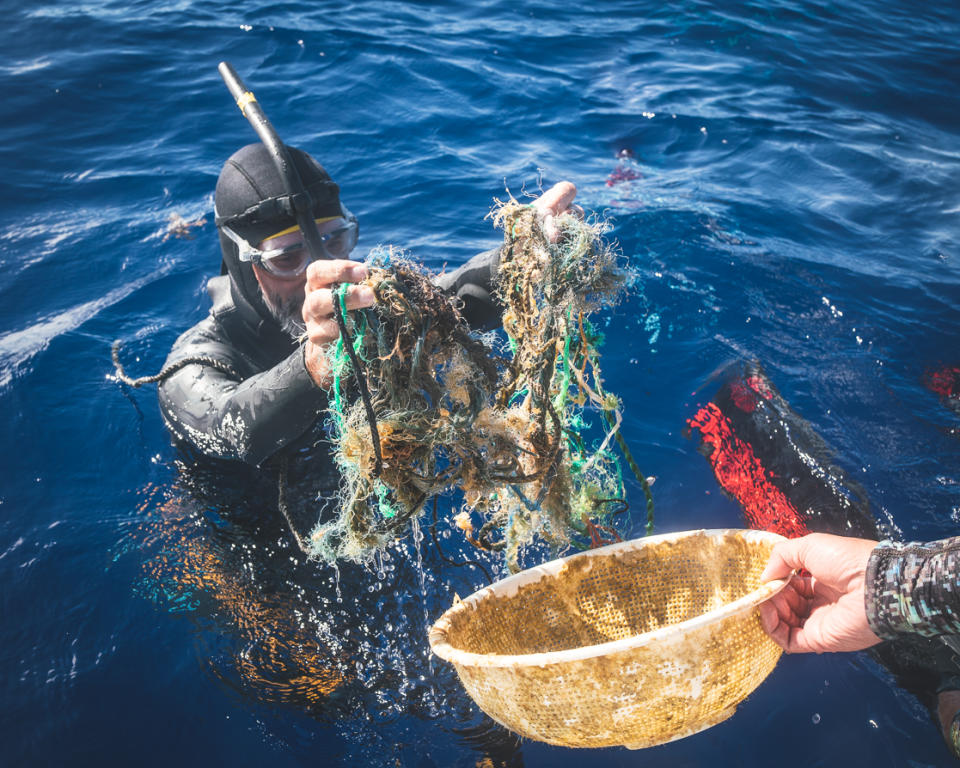Bigger than Texas: Man's alarming journey through the Pacific's largest garbage patch
Long-distance swimmer Ben Lecomte has completed an epic three-month journey from Hawaii to California, energised by brushes with majestic marine animals but alarmed by the growing human footprint in the Pacific Ocean.
A blight on the globe’s biggest expanse of water, the Great Pacific Garbage Patch continues to grow and destroy the ocean’s ecosystem.
The massive trash vortex, found halfway between Hawaii and California, is twice the size of Texas and three times the size of France.
Mr Lecomte found himself immersed in a ‘smog’ of microplastics,
He floundered among discarded dirty toothbrushes, shampoo bottles and other household products from all over the world.
“We’ve found debris that’s been left behind,” he told Yahoo News Australia.
“There’s a lot of household products like toothbrushes, razors, shampoo bottles, water bottles and a lot of microplastics.”

Plastic particle found ‘every other second’
Mr Lecomte was swimming more than 550 kilometres from Hawaii to California as part of the Vortex Swim, a voyage to raise the alarm over pollution in our ocean.
The Vortex crew discovered a plastic particle every other second during the swim and one large marine item, like toys, fishing gear and bottles, every three minutes.
Mr Lecomte has found a plastic bottle with life growing on it, a crab who has made a plastic cylinder its home and even a frog fish that had been ‘eaten’ by a plastic container.
One of the highlights for Mr Lecomte during his arduous journey was swimming just 10 metres from two sperm whales and calfs, but the awe quickly dissipated as his team collected more than 3000 microplastic fragments that same day.


They also found an albatross attempting to consume floating plastic debris.
A fish was later discovered with a piece of plastic measuring five centimetres by 1.2 centimetres rooted in its stomach.
Inside the Great Pacific Garbage Patch
The trash vortex stretches about 1.6 million square kilometres and according to environmental organisation The Ocean Cleanup, 1.15 to 2.41 million tonnes of plastic are injected into the sea from rivers each year.
The plastic swirling around the Great Pacific Ocean Patch is estimated to weigh about 80,000 tonnes, which is about the same as 500 jumbo jets.

The Ocean Cleanup claims 1.8 trillion plastic pieces are floating through the trash vortex, which equates to about 250 pieces of plastic for every person on earth.
According to the group, marine life can sometimes confuse plastics for food and consume it.
“It poses entanglement risks and threatens their overall behaviour, health and existence,” Ocean Cleanup says on its website.

“Studies have shown that about 700 species have encountered marine debris, and 92 per cent of these interactions are with plastic.”
The Ocean Cleanup says marine life passing through the Great Pacific Garbage Patch were likely consuming plastics.
Mr Lecomte told Yahoo News Australia he knew his Vortex Swim wouldn’t save the world, but hoped it would raise awareness and encourage people to change their behaviours.

“I know I’m not going to change everything. I know it will have a small impact but how we are going to solve the problem is first raise awareness and educate people little by little,” he said.
“People need to start changing their habits and need to be less dependent on plastics.”
Clothing company Icebreaker partnered with Ben Lecomte to raise awareness around the impact microplastics are having on our oceans.
Do you have a story tip? Email: newsroomau@yahoonews.com.
You can also follow us on Facebook and Twitter, download the Yahoo News app from the App Store or Google Play and stay up to date with the latest news with Yahoo’s daily newsletter. Sign up here.



